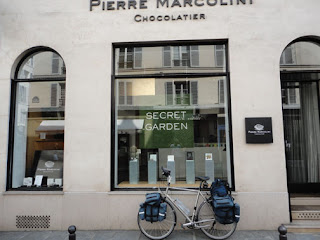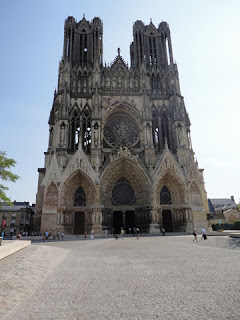Back in 2011 a week was spent cycling the streets of Paris visiting chocolatiers and pastry shops (go to my blog archive---August 2011 and read "Filling Up The Sweet Tooth in Paris" and "Porky Pig Paul Patronizes Patisseries in Paris") . Since then I've accumulated a list of more places in Paris so, I'm back again in July of 2013. There's a big problem though as the temperatures are in the mid-90's and my taste buds aren't percolating for chocolate.
However, I still fancy sweets and to be more specific: macarons. Not wanting to bore you with more snapshots of chocolate and pastry stores, I'm only posting a photo of chocolatier Pierre Marcolini's storefront. Mr. Marcolini has shops around the world including stores in Tokyo, London, New York, Brussels and even Kuwait. So, how was his chocolate? I don't know as I elected to sample some of his macarons--which were horrible!
Head about 80 miles northeast of Paris and you'll be in the midst of the Champagne-Ardenne region of France. Its vineyards produce the grapes used in making the famous bubbly stuff. If the grapes aren't from here, then you can't call it champagne. Other parts of the world have to call their bubbly stuff "sparkling wine". Reims (population 188,000) gets all the publicity for being the center of the Champagne-Ardenne region of France but, it's actually Epernay (population 24,000) 15 miles south of Reims, who's vineyards are in the epicenter. This is the headquarters of Moet & Chandon in Epernay, its best known premium label might be familiar to you: Dom Perignon.
Moet & Chandon occupies a slew of buildings on Avenue de Champagne. See the statue to the left of the tall yellow building?
It's none other than Dom Perignon. Mr. Perignon was a Benedictine monk (1638-1715) who made important contributions to the production and quality of Champagne wine. I wonder what he would say if he knew people coughed up $160 and more to buy a bottle of bubbly with his name on it?
Another 19th century building belonging to Moet & Chandon on Avenue de Champagne..
Some people call Avenue de Champagne the most expensive street in the world. Not because it's lined with absolutely gorgeous and stunning 19th century buildings but, due to millions of bottles of champagne stored in miles of chalk cellars beneath the street.
This is the entrance to Perrier Jouet's offices on Avenue de Champagne. This high-end maker of champagne traces its roots back to 1811.
Across the street from Perrier Jouet stands this beautiful edifice. Don't know who owns or occupies the building as I can't find a plaque.
I find myself even gawking at the exquisite ornamental ironwork fencing surrounding the buildings on Avenue de Champagne
I'm about a block from Reim's train station in a warehouse-type area. Why am I showing you this red brick building with an American flag outside that formerly housed Reim's technical college? Scroll down to the next photo to find out.
General Eisenhower was Supreme Allied Commander in Europe during World War II and this building was headquarters. It was here in the War Room on May 7, 1945 at 2:41 in the afternoon that General Alfred Jodl, Commander-in-Chief of the Third Reich's armed forces signed the full and unconditional surrender of Nazi Germany.
Reim's city hall
This is a backside view of Reim's magnificent Notre Dame Cathedral
This masterpiece of Gothic art dates from the 13th century
The coronation of 25 kings took place here.
Over 2,300 statues adorn the exterior.
One could spends hours marveling at the extraordinary detail.
Closer view of front entrance.
Of course I had to check out Reim's pastry and chocolate scene. My bike and I visited four places and La Chocolaterie des Sacres in downtown Reim has the best macarons.
Pistachio (the green colored ones in the right corner) were my favorite.
Veuve Clicquot Ponsardin (founded 1772) is both a Champagne house and a brand of premium champagne. Here's the entrance to the visitor center/tasting room on the edge on Reims. There's a huge factory complex in the rear.
Here's the entrance to Champagne house Pommery.
Pommery, founded in 1858, has a large complex here including a visitor center. This piece of art on the front grounds is comprised of plastic buckets--the kind workers use for gathering grapes.
This sign on Pommery's property directs people across the street to--scroll down
A spiffy historic structure used by Pommery for special functions.

























I LOVE these pictures....
ReplyDeleteThere pictures are just wonderful and I am ready to have a glass of champagne, only the best, of course!!!
ReplyDelete